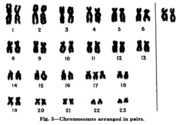
John H. Edwards
Encyclopedia

Geneticist
A geneticist is a biologist who studies genetics, the science of genes, heredity, and variation of organisms. A geneticist can be employed as a researcher or lecturer. Some geneticists perform experiments and analyze data to interpret the inheritance of skills. A geneticist is also a Consultant or...
. Edwards reported the first description of a syndrome
Syndrome
In medicine and psychology, a syndrome is the association of several clinically recognizable features, signs , symptoms , phenomena or characteristics that often occur together, so that the presence of one or more features alerts the physician to the possible presence of the others...
of multiple congenital malformations associated the presence of an extra chromosome
Chromosome
A chromosome is an organized structure of DNA and protein found in cells. It is a single piece of coiled DNA containing many genes, regulatory elements and other nucleotide sequences. Chromosomes also contain DNA-bound proteins, which serve to package the DNA and control its functions.Chromosomes...
. The extra chromosome belonged to the E group of chromosomes which consisted of chromosomes 16, 17 and 18. The condition is now known as Edwards syndrome
Edwards syndrome
Trisomy 18 is a genetic disorder caused by the presence of all or part of an extra 18th chromosome. It is named after John H. Edwards, who first described the syndrome in 1960...
or trisomy 18 syndrome.
In 1979, Edwards was elected to fellowship of the Royal Society
Royal Society
The Royal Society of London for Improving Natural Knowledge, known simply as the Royal Society, is a learned society for science, and is possibly the oldest such society in existence. Founded in November 1660, it was granted a Royal Charter by King Charles II as the "Royal Society of London"...
. He was a Fellow of Keble College, Oxford
Keble College, Oxford
Keble College is one of the constituent colleges of the University of Oxford in England. Its main buildings are on Parks Road, opposite the University Museum and the University Parks. The college is bordered to the north by Keble Road, to the south by Museum Road, and to the west by Blackhall...
and Professor of Genetics at Oxford
University of Oxford
The University of Oxford is a university located in Oxford, United Kingdom. It is the second-oldest surviving university in the world and the oldest in the English-speaking world. Although its exact date of foundation is unclear, there is evidence of teaching as far back as 1096...
from 1979 to 1995.
He was the son of the surgeon Harold C. Edwards. His brother is the geneticist and statistician A.W.F. Edwards. Early in his career, he worked under Lancelot Hogben
Lancelot Hogben
Lancelot Thomas Hogben FRS was a versatile British experimental zoologist and medical statistician. He is best known for developing Xenopus laevis as a model organism for biological research in his early career, attacking the eugenics movement in the middle of his career, and popularising books on...
, and was sometimes distinguished from the brother as Hogben's Edwards
The Edwards brothers, Fisher, and Hogben
The brothers John H. and A.W.F. Edwards, and their respective mentors Lancelot Hogben and Ronald Fisher, were scientists in the 20th century. The two senior researchers developed opposing theories on the genotype-environment interaction ; the elder brother, John, came to be known as "Hogben's...
.

